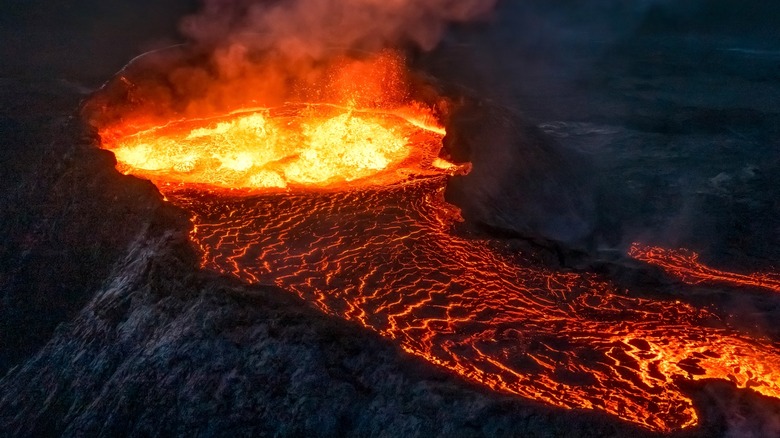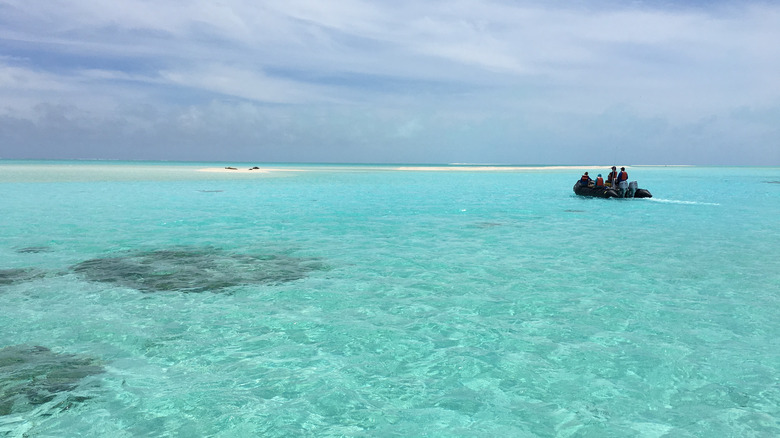A Bizarre Ocean Discovery That Had Scientists Thinking They Were In The Wizard Of Oz
The incredible fiery wrath of volcanoes can create many things: mountains, craters, rivers of lava (via National Geographic), and oceanic islands (via National Geographic). Their power can even trigger natural disasters like tsunamis, when tons of water are displaced by their underwater blasts (via The Australian Museum), and earthquakes due to pressure build up and magma movement causing the surrounding ground to fail (via Pacific Northwest Seismic Network). Despite all of this power, you probably wouldn't expect volcanoes to be able to replicate a popular 1930s movie set (via History).
At the bottom of the Pacific Ocean, a group of scientists made a groundbreaking discovery this past April (via CNET). The team of scientists in question, known as the crew of the Exploration Vessel Nautilus, have found plenty of strange sea life and seascapes in their travels, including dumbo octopuses, a jelly-like purple blob off the coast of California, a brine pool known as the "hot tub of despair" in the Gulf of Mexico, and a bug-eyed cephalopod that almost looks like a toy, called the stubby squid (via Mental Floss). But this time was a bit different. Remember that part of Victor Fleming's 1939 "The Wizard of Oz" where Dorothy says, "Toto, I have a feeling we're not in Kansas anymore"? Well, that's probably how these scientists felt too while plumbing the depths of the unknown.
The Yellow Brick Road
The crew of the Exploration Vessel Nautilus, who have found countless rare species and strange sights in their adventures, found something that looked like it could have been transported from Oz. While studying the seafloor off the coast of Hawaii in an area called Lili'uokalani Ridge in the Papahānaumokuakea Marine National Monument (via CNET), their camera picked up footage (which can be seen here) of a cobblestone-like path, reminiscent of the yellow brick road Dorothy and her friends walked in "The Wizard of Oz" (via Mental Floss).
Researchers have not only made this comparison after viewing the footage, but they have also called the formation "the road to Atlantis." While these fantastical theories would be a dream if true, scientists say the formation was caused by volcanic rock, called hyaloclastite rock, which can only be formed when the debris from strong eruptions settles on the seafloor. The similarity to cobblestone results from the rapid heating and cooling of the stone.
More Discoveries to be Made
The mineral makeup of rocks on the seafloor can teach scientists a lot about geology and geochemistry (via Hawaii Public Radio). In the Lili'uokalani Ridge region of the Papahānaumokuakea Marine National Monument alone (via CNET), named to reflect Kānaka (Native Hawaiian) culture (via Nautilus Live), there are massive plumes of biodiversity including rare corals, starfish, and sponges (via National Oceanic and Atmospheric Administration: Ocean Exploration). In fact, minerals from this area indicated that some of its underwater mountains nearer to the Northwestern Hawaiian Islands were not from the area at all, and in fact migrated from the South Pacific during tectonic shifts.
Only three percent of this region's seafloor has been mapped, and less than 10 percent of the global seafloor (via National Oceanic and Atmospheric Administration: National Ocean Surface). With so little ground covered, there is so much more to be discovered. From 20th century film sets to cartoon-like squids, we'll keep watching for whatever crazy discovery marine scientists find next.


